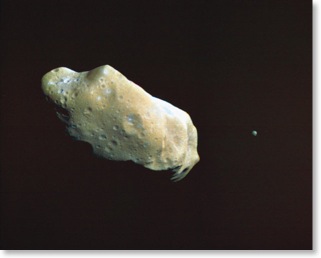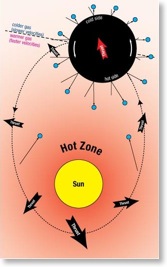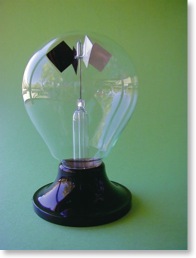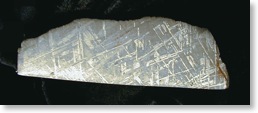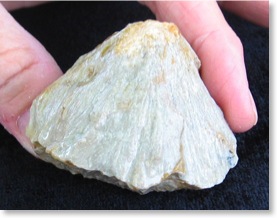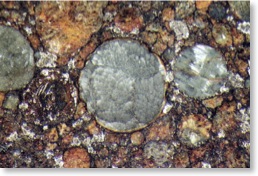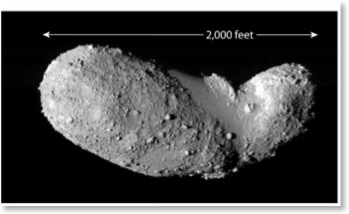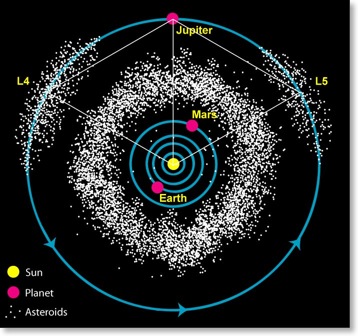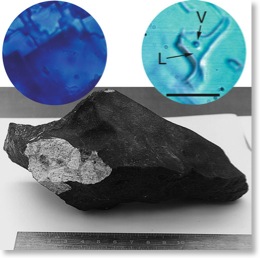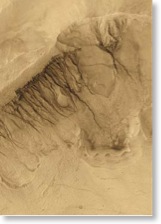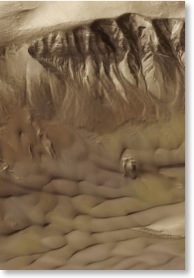The Origin of Asteroids
by Dr. Walt Brown(This article has been reproduced with permission from the Center for Scientific Creation. The original article can be found here.)
NOTE - In order to fully understand the content of this article (and it’s companion article The Origin of Comets), you should read the book, In the Beginning by Dr. Walt Brown. This book fully explains Dr. Brown’s Hydroplate Theory which is the foundation upon which this article is written. In fact, this “article” is actually a chapter in the book, In the Beginning. Members of the 4th Day Alliance can download the complete PDF copy of this chapter by clicking here.
Figure 156: Asteroid Ida and Its Moon, Dactyl. In 1993, the Galileo spacecraft, heading toward Jupiter, took this picture 2,000 miles from asteroid Ida. To the surprise of most, Ida had a moon (about 1 mile in diameter) orbiting 60 miles away! Both Ida and Dactyl are composed of earthlike rock. We now know of 68 other asteroids that have moons.1 According to the laws of orbital mechanics (described in the preceding chapter), capturing a moon in space is unbelievably difficult—unless both the asteroid and a nearby potential moon had very similar speeds and directions and unless gases surrounded the asteroid during capture. If so, the asteroid, its moon, and each gas molecule were probably coming from the same place and were launched at about the same time. Within a million years, passing bodies would have stripped the moons away, so these asteroid-moon captures must have been recent.
From a distance, large asteroids look like big rocks. However, many show, by their low density, that they contain either much empty space or something light, such as water ice.2 Also, the best close-up pictures of an asteroid show millions of smaller rocks on its surface. Therefore, asteroids are flying rock piles held together by gravity. Ida, about 35 miles long, does not have enough gravity to squeeze itself into a spherical shape.
SUMMARY: The fountains of the great deep launched rocks as well as muddy water. As rocks moved farther from Earth, Earth’s gravity became less significant to them, and the gravity of nearby rocks became increasingly significant. Consequently, many rocks, assisted by their mutual gravity and surrounding clouds of water vapor, merged to become asteroids. Isolated rocks in space are meteoroids. Drag forces caused by water vapor and thrust forces produced by the radiometer effect concentrated asteroids in what is now the asteroid belt. All the so-called “mavericks of the solar system” (asteroids, meteoroids, and comets) resulted from the explosive events at the beginning of the flood.
Asteroids, also called minor planets, are rocky bodies orbiting the Sun. The orbits of most asteroids lie between those of Mars and Jupiter, a region called the asteroid belt. The largest asteroid, Ceres, is almost 600 miles in diameter and has about one-third the volume of all other asteroids combined. Orbits of almost 30,000 asteroids have been calculated. Many more asteroids have been detected, some less than 20 feet in diameter. A few that cross the Earth’s orbit would do great damage if they ever collided with Earth.
Two explanations are given for the origin of asteroids: (1) they were produced by an exploded planet, and (2) a planet failed to evolve completely. Experts recognize the problems with each explanation and are puzzled. The hydroplate theory offers a simple and complete—but quite different—solution that also answers other questions.
Meteorites, Meteors, and Meteoroids
In space, solid bodies smaller than an asteroid but larger than a molecule are called “meteoroids.” They are renamed “meteors” as they travel through Earth’s atmosphere, and “meteorites” if they hit the ground.Exploded-Planet Explanation. Smaller asteroids are more numerous than larger asteroids, a pattern typical of fragmented bodies. Seeing this pattern led to the early belief that asteroids are remains of an exploded planet. Later, scientists realized that all the fragments combined would not make up one small planet.3 Besides, too much energy is needed to explode and scatter even the smallest planet.
Failed-Planet Explanation. The most popular explanation today for asteroids is that they are bodies that did not merge to become a planet. Never explained is how, in nearly empty space, matter merged to become these rocky bodies in the first place,4 why rocky bodies started to form a planet but stopped,5 or why it happened only between the orbits of Mars and Jupiter. Also, because only vague explanations have been given for how planets formed, any claim to understand how one planet failed to form lacks credibility. In general, orbiting rocks do not merge to become either planets or asteroids. Special conditions are required, as explained on page 267 and Endnote 23 on page 288.] Today, collisions and near collisions fragment and scatter asteroids, just the opposite of this “failed-planet explanation.” In fact, during the 4,600,000,000 years evolutionists say asteroids have existed, asteroids would have had so many collisions that they should be much more fragmented than they are today.6
Hydroplate Explanation. Asteroids are composed of rocks expelled from Earth. The size distribution of asteroids does show that at least part of a planet fragmented. Although an energy source is not available to explode and disperse an entire Earth-size planet, the eruption of so much supercritical water from the subterranean chambers could have launched one 2,300th of the Earth—the mass of all asteroids combined. Astronomers have tried to describe the exploded planet, not realizing they were standing on the remaining 99.95% of it—too close to see it.7
As flood waters escaped from the subterranean chambers, pillars, forced to carry more and more of the weight of the overlying crust, were crushed. Also, the almost 10-mile-high walls of the rupture were unstable, because rock is not strong enough to support a cliff more than 5 miles high. As lower portions of the walls were crushed, large blocks8 were swept up and launched by the jetting fountains. Unsupported rock in the top 5 miles then fragmented. The smaller the rock, the faster it accelerated and the farther it went, just as a rapidly flowing stream carries smaller dirt particles faster and farther.
Water droplets in the fountains partially evaporated and quickly froze. Large rocks had large spheres of influence which grew as the rocks traveled away from Earth. Larger rocks became “seeds” around which other rocks and ice collected as spheres of influence expanded. Because of all the evaporated water vapor and the resulting aerobraking, even more mass concentrated around the “seeds.”Clumps of rocks became asteroids.
Question 1: Why did some clumps of rocks and ice in space become asteroids and others become comets?
Imagine living in a part of the world where heavy frost settled each night, but the Sun shone daily. After many decades, would the countryside be buried in hundreds of feet of frost?The answer depends on several things besides the obvious need for a large source of water. If dark rocks initially covered the ground, the Sun would heat them during the day, so frost from the previous night would tend to evaporate. However, if the sunlight was dim or the frost was thick (thereby reflecting more sunlight during the day), little frost would evaporate. More frost would accumulate the next night. Frost thickness would increase every 24 hours.
Now imagine living on a newly formed asteroid. Its spin would give you day-night cycles. After sunset, surface temperatures would plummet toward nearly absolute zero (-460°F), because asteroids do not have enough gravity to hold an atmosphere for long. With little atmosphere to insulate the asteroid, the day’s heat would quickly radiate, unimpeded, into outer space. Conversely, when the Sun rose, its rays would have little atmosphere to warm, so temperatures at the asteroid’s surface would rise rapidly.
As the fountains of the great deep launched rocks and water droplets, evaporation in space dispersed an “ocean” of water molecules and other gases in the inner solar system. Gas molecules that struck the cold side of your spinning asteroid would become frost.9 Sunlight would usually be dim on rocks in larger, more elongated orbits. Therefore, little frost would evaporate during the day, and the frost’s thickness would increase. Your “world” would become a comet. However, if your “world” orbited relatively near the Sun, its rays would evaporate each night’s frost, so your “world” would remain an asteroid.
Heavier rocks could not be launched with as much velocity as smaller particles (dirt, water droplets, and smaller rocks). The heavier rocks merged to become asteroids, while the smaller particles, primarily water, merged to become comets, which generally have larger orbits. No “sharp line” separates asteroids and comets.
PREDICTION 33
Asteroids are rock piles, often with ice acting as a weak “glue” inside. Large rocks that began the capture process are nearer the centers of asteroids. Comets, which are primarily ice, have rocks in their cores. Four years after this prediction was published in 2001 (In the Beginning, 7th edition, page 220), measurements of the largest asteroid, Ceres, found that it does indeed have a dense, rocky core and primarily a water-ice mantle.10Question 2: Wasn’t asteroid Eros found to be primarily a large, solid rock?
A pile of dry sand here on Earth cannot maintain a slope greater than about 30 degrees. If it were steeper, the sand grains would roll downhill. Likewise, a pile of dry pebbles or rocks on an asteroid cannot have a slope exceeding about 30 degrees. However, 4% of Eros’ surface exceeds this slope, so some scientists concluded that much of Eros must be a large, solid rock. This conclusion overlooks the possibility that ice is present between some rocks and acts as a weak glue—as predicted above. Ice in asteroids would also explain their low density. Endnote 8 gives another reason why asteroids are probably flying rock piles.Question 3: Objects launched from Earth should travel in elliptical, cometlike orbits. How could rocky bodies launched from Earth become concentrated in almost circular orbits between Mars and Jupiter?
Gases, such as water vapor and its components,11 were abundant in the inner solar system for many years after the flood. Hot gas molecules striking each asteroid’s hot side were repelled with great force. This jetting action was like air rapidly escaping from a balloon, applying a thrust in a direction opposite to the escaping gas.12 Cold molecules striking each asteroid’s cold side produced less jetting. This thrusting, efficiently powered by solar energy, pushed asteroids outward, away from the sun, concentrating them between the orbits of Mars and Jupiter.13 [See Figures 157 and 158.]Figure 157: Thrust and Drag Acted on Asteroids (Sun, asteroid, gas molecules, and orbit are not to scale.) The fountains of the great deep launched rocks and muddy water from Earth. The larger rocks, assisted by water vapor and other gases within the spheres of influence of these rocks, captured other rocks and ice particles. Those growing bodies that were primarily rocks became asteroids.
The Sun heats an asteroid’s near side, while the far side radiates its heat into cold outer space. Therefore, large temperature differences exist on opposite sides of each rocky, orbiting body. The slower the body spins, the darker the body,14 and the closer it is to the Sun, the greater the temperature difference. (For example, temperatures on the sunny side of our Moon reach a searing 260°F, while on the dark side, temperatures can drop to a frigid -280°F.) Also, gas molecules (small blue circles) between the Sun and asteroid, especially those coming from very near the Sun, are hotter and faster than those on the far side of an asteroid. Hot gas molecules hitting the hot side of an asteroid bounce off with much higher velocity and momentum than cold gas molecules bouncing off the cold side. Those impacts slowly expanded asteroid orbits until too little gas remained in the inner solar system to provide much thrust. The closer an asteroid was to the Sun, the greater the outward thrust. Gas molecules, densely concentrated near Earth’s orbit, created a drag on asteroids. My computer simulations have shown how gas, throughout the inner solar system for years after the flood, herded asteroids into a tight region near Earth’s orbital plane—an asteroid belt.15 Thrust primarily expanded the orbits. Drag circularized orbits and reduced their angles of inclination.
Figure 158: The Radiometer Effect. This well-known novelty, called a radiometer, demonstrates the unusual thrust that pushed asteroids into their present orbits. Sunlight warms the dark side of each vane more than the light side. The partial vacuum inside the bulb approaches that found in outer space, so gas molecules travel relatively long distances before striking other molecules. Gas molecules bounce off the hotter, black side with greater velocity than off the colder, white side. This turns the vanes away from the dark side.
The black side also radiates heat faster when it is warmer than its surroundings. This can be demonstrated by briefly placing the radiometer in a freezer. There the black side cools faster, making the white side warmer than the black, so the vanes turn away from the white side. In summary, the black side gains heat faster when in a hot environment and loses heat faster when in a cold environment. Higher gas pressure always pushes on the warmer side.
Question 4: Could the radiometer effect push asteroids 1–2 astronomical units (AU) farther from the Sun?
Each asteroid began as a swarm of particles (rocks, ice, and gas molecules) orbiting within a large sphere of influence. Because a swarm’s volume was quite large, its spin was much slower than it would be as it shrank to become an asteroid—perhaps orders of magnitude slower. The slow spin produced extreme temperature differences between the hot and cold sides. The cold side would have been so cold that gas molecules striking it would tend to stick, thereby adding “fuel” to the developing asteroid. Because the swarm’s volume was large, the radiometer pressure acted over a large area and produced a large thrust. The swarm’s large thrust and low density caused the swarm to rapidly accelerate—much like a feather placed in a gentle breeze. Also, the Sun’s gravity 93,000,000 miles from the Sun (the Earth-Sun distance) is 1,600 times weaker than Earth’s gravity here on Earth.17 So, pushing a swarm of rocks and debris farther from the Sun was surprisingly easy, because there is almost no resistance in outer space.Question 5: Why are 4% of meteorites almost entirely iron and nickel? Also, why do meteorites rarely contain quartz, which constitutes about 27% of granite’s volume?
Pillars were formed in the subterranean chamber when the thicker portions of the crust were squeezed downward onto the chamber floor. Twice daily, during the centuries before the flood, these pillars were stretched and compressed by tides in the subterranean water. This gigantic heating process steadily raised pillar temperatures. [See “What Triggered the Flood?” here.] As explained in Figure 159, temperatures in what are now iron-nickel meteorites once exceeded 1,300°F, enough to dissolve quartz and allow iron and nickel to settle downward and become concentrated in the pillar tips.18 (A similar gravitational settling process concentrated iron and nickel in the Earth’s core after the flood began. See “Melting the Inner Earth” here.)Evolutionists have great difficulty explaining iron-nickel meteorites. First, everyone recognizes that a powerful heating mechanism must first melt at least some of the parent body from which the iron-nickel meteorites came, so iron and nickel can sink and be concentrated. How this could have occurred in the weak gravity of extremely cold asteroids has defied explanation.19 Second, the concentrated iron and nickel, which evolutionists visualize in the core of a large asteroid, must then be excavated and blasted into space. Available evidence shows that this has not happened.20
Figure 156: Asteroid Ida and Its Moon, Dactyl. Most iron-nickel meteorites display Widmanstätten patterns. That is, if an iron-nickel meteorite is cut and its face is polished and then etched with acid, the surface has the strange crisscross pattern shown above. This shows that temperatures throughout those meteorites exceeded 1,300°F.16 Why were so many meteoroids, drifting in cold space, at one time so uniformly hot? An impact would not produce such uniformity, nor would a blowtorch. The heating a meteor experiences in passing through the atmosphere is barely felt more than a fraction of an inch beneath the surface. If radioactive decay generated the heat, certain daughter products should be present; they are not. Question 5 explains how these high temperatures were probably reached.
Question 6: Aren’t meteoroids chips from asteroids?
This commonly-taught idea is based on an error in logic. Asteroids and meteoroids have some similarities, but that does not mean that one came from the other. Maybe a common event produced both asteroids and meteoroids.Also, three major discoveries suggest that meteoroids came not from asteroids, but from Earth.
1. In the mid-1970s, the Pioneer 10 and 11 spacecraft traveled out through the asteroid belt. NASA expected that the particle detection experiments on board would find 10 times more meteoroids in the belt than are present near Earth’s orbit.21 Surprisingly, the number of meteoroids diminished as the asteroid belt was approached.22 This showed that meteoroids are not coming from asteroids but from nearer the Earth’s orbit.
2. A faint glow of light, called the zodiacal light, extends from the orbit of Venus out to the asteroid belt. The light is reflected sunlight bouncing off dust-size particles. This lens-shaped swarm of particles orbits the Sun, near Earth’s orbital plane. (On dark, moonless nights, zodiacal light can be seen in the spring in the western sky after sunset and in the fall in the eastern sky before sunrise.) Debris chipped off asteroids would have a wide range of sizes and would not be as uniform and fine as the particles reflecting the zodiacal light. Debris expelled by the fountains of the great deep would place fine dust particles in the Earth's orbital plane.
3. Many meteorites have remanent magnetism, so they must have come from a larger magnetized body. Eros, the only asteroid on which a spacecraft has landed and taken magnetic measurements, has no net magnetic field. If this is true of other asteroids as well, meteorites probably did not come from asteroids.30 If asteroids are flying rock piles, as it now appears, any magnetic fields in the randomly oriented rocks would be largely self-canceling, so the asteroid would have no net magnetic field. Therefore, instead of coming from asteroids, meteorites likely came from a magnetized body such as a planet. Because Earth’s magnetic field is 2,000 times greater than that of all other rocky planets combined, meteorites probably came from Earth.
Remanent magnetism decays, so meteorites must have recently broken away from their parent magnetized body. Those who believe that meteorites were chipped off asteroids say this happened millions of years ago.
PREDICTION 34:
Most rocks comprising asteroids will be found to be magnetized.Two Interpretations
With a transmission electron microscope, Japanese scientist Kazushige Tomeoka identified several major events in the life of one meteorite. Initially, this meteorite was part of a much larger parent body orbiting the Sun. The parent body had many thin cracks, through which mineral-rich water cycled. Extremely thin mineral layers were deposited on the walls of these cracks. These deposits, sometimes hundreds of layers thick, contained calcium, magnesium, carbonates, and other chemicals. Mild thermal metamorphism in this rock shows that temperatures increased before it experienced some final cracks and was blasted into space.31Hydroplate Interpretation. Earth was the parent body of all meteorites, most of which came from pillars. [Pages 381–386 explain how, why, when, and where pillars formed.] Twice a day before the flood, tides in the subterranean water compressed and stretched these pillars. Compressive heating occurred and cracks developed. Just as water circulates through a submerged sponge that is squeezed and stretched, mineral-laden water circulated through cracks in pillars for years before they broke up. Pillar fragments, launched into space by the fountains of the great deep, became meteoroids. In summary, water did it.
Tomeoka’s (and Most Evolutionists’) Interpretation. Impacts on an asteroid cracked the rock that was to become this meteorite. Ice was deposited on the asteroid. Impacts melted the ice, allowing liquid water to circulate through the cracks and deposit hundreds of layers of magnesium, calcium, and carbonate bearing minerals. A final impact blasted rocks from this asteroid into space. In summary, impacts did it.
Figure 160: Shatter Cone. When a large, crater-forming meteorite strikes the Earth, a shock wave radiates outward from the impact point. The passing shock wave breaks the rock surrounding the crater into meteorite-size fragments having distinctive patterns called shatter cones. (Until shatter cones were associated with impact craters by Robert S. Dietz in 1969, impact craters were often difficult to identify.)
If large impacts on asteroids launched asteroid fragments toward Earth as meteorites, a few meteorites should have shatter cone patterns. None have ever been reported. Therefore, meteorites are probably not derived from asteroids. Likewise, impacts have not launched meteorites from Mars.
Question 7: Does other evidence support this hypothesis that asteroids and meteoroids came from Earth?
Yes. Here are seventeen additional observations that either support the proposed explanation or are inconsistent with other current theories on the origin of asteroids and meteoroids:1. The materials in meteorites and meteoroids are remarkably similar to those in the Earth’s crust.32 Some meteorites contain very dense elements, such as nickel and iron. Those heavy elements seem compatible only with the denser rocky planets: Mercury, Venus, and Earth—Earth being the densest.
A few asteroid densities have been calculated. They are generally low, ranging from 1.2 to 3.3 gm/cm3. The higher densities match those of the Earth’s crust. The lower densities imply the presence of empty space between loosely held rocks or something light such as water ice.33
PREDICTION 35:
Rocks in asteroids are typical of the Earth’s crust. Expensive efforts to mine asteroids34 to recover strategic or precious metals will be a waste of money.2. Meteorites contain different varieties (isotopes) of the chemical element molybdenum, each isotope having a slightly different atomic weight. If, as evolutionists teach, a swirling cloud of gas and dust mixed for millions of years and produced the Sun, its planets, and meteorites, then each meteorite should have about the same combination of these molybdenum isotopes. Because this is not the case,35 meteorites did not come from a swirling dust cloud or any source that mixed for millions of years.
3. Most meteorites36 and some asteroids37 contain metamorphosed minerals, showing that those bodies reached extremely high temperatures, despite a lifetime in the “deep freeze” of outer space. Radioactive decay within such relatively small bodies could not have produced the necessary heating, because too much heat would have escaped from their surfaces. Stranger still, liquid water altered some meteorites38 while they and their parent bodies were heated—sometimes heated multiple times.39
Impacts in space are often proposed to explain this mysterious heating throughout an asteroid or meteroite. However, an impact would raise the temperature only near the point of impact. Before gravel-size fragments from an impact could become uniformly hot, they would radiate their heat into outer space.40
For centuries before the flood, heat was steadily generated within pillars in the subterranean water chamber. As the flood began, the powerful jetting water launched rock fragments into space—fragments of hot, crushed pillars and fragments from the crumbling walls of the ruptured crust. Those rocks became meteoroids and asteroids.
4. Because asteroids came from Earth, they typically spin in the same direction as Earth (counterclockwise, as seen from the North). However, collisions have undoubtedly randomized the spins of many smaller asteroids in the last few thousand years.41
5. Some asteroids have captured one or more moons. [See Figure 156 at top of this page.] Sometimes the “moon” and asteroid are similar in size. Impacts would not create equal-size fragments that could capture each other.42 The only conceivable way for this to happen is if a potential moon enters an asteroid’s expanding sphere of influence while traveling about the same speed and direction as the asteroid. If even a thin gas surrounds the asteroid, the moon will be drawn closer to the asteroid, preventing the moon from being stripped away later. An “exploded planet” would disperse relatively little gas. The “failed planet explanation” meets none of the requirements. The hydroplate theory satisfies all the requirements.
Figure 161: Chondrules. The central chondrule above is 2.2 millimeters in diameter, the size of this circle: o. This picture was taken in reflected light. However, meteorites containing chondrules can be thinly sliced and polished, allowing light from below to pass through the thin slice and into the microscope. Such light becomes polarized as it passes through the minerals. The resulting colors identify minerals in and around the chondrules. [Meteorite from Hammada al Hamra Plateau, Libya.]
Chondrules (CON-drools) are strange, spherical, BB-size objects found in 86% of all meteorites. To understand the origin of meteorites we must also understand how chondrules formed.
Their spherical shape and texture show they were once molten, but to melt chondrules requires temperatures exceeding 3,000°F. How could chondrules get that hot without melting the surrounding rock, which usually has a lower melting temperature? Because chondrules contain volatile substances that would have bubbled out of melted rock, chondrules must have melted and cooled quite rapidly.23 By one estimate, melting occurred in about one-hundredth of a second.24
The standard explanation for chondrules is that small pieces of rock, moving in outer space billions of years ago, before the Sun and Earth formed, suddenly and mysteriously melted. These liquid droplets quickly cooled, solidified, and then were encased inside the rock that now surrounds them. Such vague conditions, hidden behind a veil of space and time, make it nearly impossible to test this explanation in a laboratory. Scientists recognize that this standard story does not explain the rapid melting and cooling of chondrules or how they were encased uniformly in rocks which are radiometrically older than the chondrules.25 As one scientist wrote, “The heat source of chondrule melting remains uncertain. We know from the petrological data that we are looking for a very rapid heating source, but what?”26
Frequently, minerals grade (gradually change) across the boundaries between chondrules and surrounding material.27 This suggests that chondrules melted while encased in rock. If so, the heating sources must have acted briefly and been localized near the center of what are now chondrules. But how could this have happened?
The most common mineral in chondrules is olivine.28 Deep rocks contain many BB-size pockets of olivine. Pillars within the subterranean water probably had similar pockets. As the subterranean water escaped from under the crust, pillars had to carry more of the crust’s weight. When olivine reaches a certain level of compression, it suddenly changes into another mineral, called spinel (spin-EL), and shrinks in volume by about 10%.29 (Material surrounding each pocket would not shrink.)
Tiny, collapsing pockets of olivine transforming into spinel would generate great heat, for two reasons. First, the transformation is exothermic; that is, it releases heat chemically. Second, it releases heat mechanically, by friction. Here’s why. At the atomic level, each pocket would collapse in many stages—much like falling dominos or the section-by-section crushing of a giant scaffolding holding up an overloaded roof. Within each pocket, as each microscopic crystal slid over adjacent crystals at these extreme pressures, melting would occur along sliding surfaces. The remaining solid structures in the olivine pocket would then carry the entire compressive load—quickly collapsing and melting other parts of the “scaffolding.”
The fountains of the great deep expelled pieces of crushed pillars into outer space where they rapidly cooled. Their tumbling action, especially in the weightlessness of space, would have prevented volatiles from bubbling out of the encased liquid pockets within each rock. In summary, chondrules are a by product of the mechanism that produced meteorites—a rapid process that started under the Earth’s crust as the flood began.
Also, tidal effects, as described on pages 425–428, limit the lifetime of the moons of asteroids to about 100,000 years.43 This fact and the problems in capturing a moon caused evolutionist astronomers to scoff at early reports that some asteroids have moons.
Figure 162: Peanut Asteroids. The fountains of the great deep expelled dirt, rocks, and considerable water from Earth. About half of that water quickly evaporated into the vacuum of space; the remainder froze. Each evaporated gas molecule became an orbiting body in the solar system. Asteroids then formed as explained on pages 298–302. Many are shaped like peanuts.
Gas molecules captured by asteroids or released by icy asteroids became their atmospheres. Asteroids with thick atmospheres sometimes captured smaller asteroids as moons. If an atmosphere remained long enough, the moon would lose altitude and gently merge with the low-gravity asteroid, forming a peanut-shaped asteroid. (We see merging when a satellite or spacecraft reenters Earth’s atmosphere, slowly loses altitude, and eventually falls to Earth.) Without an atmosphere, merging becomes almost impossible.
Japan’s Hayabusa spacecraft orbited asteroid Itokawa (shown above) for two months in 2005. Scientists studying Itokawa concluded that it consists of two smaller asteroids that merged. Donald Yeomans, a mission scientist and member of NASA’s Jet Propulsion Laboratory, admitted, “It’s a major mystery how two objects each the size of skyscrapers could collide without blowing each other to smithereens. This is especially puzzling in a region of the solar system where gravitational forces would normally involve collision speeds of 2 km/sec.”45 The mystery is easily solved when one understands the role that water played in the origin of comets and asteroids.
Notice, a myriad of rounded boulders, some 150 feet in diameter, litter Itokawa’s surface. High velocity water produces rounded boulders; an exploded planet or impacts on asteroids would produce angular rocks.
6. The smaller moons of the giant planets (Jupiter, Saturn, Uranus, and Neptune) are captured asteroids. Most astronomers probably accept this conclusion, but have no idea how these captures could occur.44
As explained earlier in this chapter, for decades to centuries after the flood the radiometer effect, powered by the Sun’s energy, spiraled asteroids outward from Earth’s orbit. Water vapor, around asteroids and in interplanetary space, temporarily thickened asteroid and planet atmospheres. This facilitated aerobraking which allowed massive planets to capture asteroids.
Recent discoveries indicate that Saturn’s 313-mile-wide moon, Enceladus (en-SELL-uh-duhs), is a captured asteroid. Geysers at Enceladus’ south pole are expelling water vapor and ice crystals which escape Enceladus and supply Saturn’s E ring.46 That water contains salts resembling Earth’s ocean waters.47 Because asteroids are icy and weak, they would experience strong tides if captured by a giant planet. Strong tides would have recently48 generated considerable internal heat, slowed the moon’s spin, melted ice, and boiled deep reservoirs of water. Enceladus’ spin has almost stopped, its internal water is being launched (some so hot that it becomes a plasma),49 and its surface near the geysers has buckled, probably due to the loss of internal water. Because the material for asteroids and their organic matter came recently from Earth, water is still jetting from cold Enceladus’ surprisingly warm south pole, and “dark green organic material”50 is on its surface.
7. A few asteroids suddenly develop comet tails, so they are considered both asteroid and comet. The hydroplate theory says that asteroids are weakly joined piles of rocks and ice. If such a pile cracked slightly, perhaps due to an impact by space debris, then internal ice, suddenly exposed to the vacuum of space, would violently vent water vapor and produce a comet tail. The hydroplate theory explains why comets are so similar to asteroids.
8. A few comets have nearly circular orbits within the asteroid belt. Their tails lengthen as they approach perihelion and recede as they approach aphelion. If comets formed beyond the planet Neptune, it is highly improbable that they could end up in nearly circular orbits in the asteroid belt.51 So, these comets almost certainly did not form in the outer solar system. Also, comet ice that near the Sun would evaporate relatively quickly. Only the hydroplate theory explains how comets (icy rock piles) recently entered the asteroid belt.
9. If asteroids passing near Earth came from the asteroid belt, too many of them have diameters less than 50 meters,52 and too many have circular orbits.53 However, we would expect this if the rocks that formed asteroids were launched from Earth.
10. Computer simulations, both forward and backward in time, show that asteroids traveling near Earth have a maximum expected lifetime of only about a million years. They “quickly” collide with the Sun.54 This raises doubts that all asteroids began 4,600,000,000 years ago as evolutionists claim—living 4,600 times longer than the expected lifetime of near-Earth asteroids.
11. Earth has one big moon and several small moons—up to 650 feet in diameter.55 The easiest explanation for the small moons is that they were launched from Earth with barely enough velocity to escape Earth’s gravity. (To understand why the largest of these small moons is about 650 feet in diameter, see Endnote 8.)
12. Asteroids 3753 Cruithne and 2000 AA29 are traveling companions of Earth.56 They delicately oscillate, in a horseshoe pattern, around two points that lie 60° (as viewed from the Sun) forward and 60° behind the Earth but on Earth’s nearly circular orbit. These points, predicted by Lagrange in 1764 and called Lagrange points, are stable places where an object would not move relative to the Earth and Sun if it could once occupy either point going at zero velocity relative to the Earth and Sun. But how could a slowly moving object ever reach, or get near, either point? Most likely, it barely escaped from Earth.
Also, Asteroid 3753 could not have been in its present orbit for long, because it is so easy for a passing gravitational body to perturb it out of its stable niche. Time permitting, Venus will pass near this asteroid 8,000 years from now and may dislodge it.57
13. Furthermore, Jupiter has two Lagrange points on its nearly circular orbit. The first, called L4, lies 60° (as seen from the Sun) in the direction of Jupiter’s motion. The second, called L5, lies 60° behind Jupiter.
Visualize planets and asteroids as large and small marbles rolling in orbitlike paths around the Sun on a large frictionless table. At each Lagrange point is a bowl-shaped depression that moves along with each planet. Because there is no friction, small marbles (asteroids) that roll down into a bowl normally pick up enough speed to roll back out. However, if a chance gravitational encounter slowed one marble right after it entered a bowl, it might not exit the bowl. Marbles trapped in a bowl would normally stay 60° ahead of or behind their planet, gently rolling around near the bottom of their moving bowl.
One might think an asteroid is just as likely to get trapped in Jupiter’s leading bowl as its trailing bowl—a 50–50 chance, as with the flip of a coin. Surprisingly, 1068 asteroids are in Jupiter’s leading (L4) bowl, but only 681 are in the trailing bowl.69 This shouldn’t happen in a trillion trials if an asteroid is just as likely to get trapped at L4 as L5. What concentrated so many asteroids near the L4 Lagrange point?
According to the hydroplate theory, asteroids formed near Earth’s orbit. Then, the radiometer effect spiraled them outward, toward the orbits of Mars and Jupiter. Some spiraled through Jupiter’s circular orbit and passed near both L4 and L5. Jupiter’s huge gravity would have slowed those asteroids that were moving away from Jupiter but toward L4. That braking action would have helped some asteroids settle into the L4 bowl. Conversely, asteroids that entered L5 were accelerated toward Jupiter, so they would quickly be pulled out of L5 by Jupiter’s gravity. The surprising excess of asteroids near Jupiter’s L4 is what we would expect based on the hydroplate theory.
Figure 163: Asteroid Belt and Jupiter’s L4 and L5. The size of the Sun, planets, and especially asteroids are magnified, but their relative positions are accurate. About 90% of the 30,000 precisely known asteroids lie between the orbits of Mars and Jupiter, a doughnut-shaped region called the asteroid belt. A few small asteroids cross Earth’s orbit.
Jupiter’s Lagrange points, L4 and L5, lie 60° ahead and 60° behind Jupiter, respectively. They move about the Sun at the same velocity as Jupiter, as if they were fixed at the corners of the two equilateral triangles shown. Items 12 and 13 explain why so many asteroids have settled near L4 and L5, and why significantly more oscillate around L4 than L5.
14. Without the hydroplate theory, one has difficulty imagining situations in which an asteroid would (a) settle into one of Jupiter’s Lagrange points, (b) capture a moon, especially a moon with about the same mass as the asteroid, or (c) have a circular orbit, along with its moon, about their common center of mass. If all three happened to an asteroid, astronomers would be shocked; no astronomer would have predicted that it could happen to a comet. Nevertheless, an “asteroid” discovered earlier, named 617 Patroclus, satisfies (a)–(c). Patroclus and its moon, Menoetius, have such low densities that they would float in water; therefore, both are probably comets70—dirty, fluffy snowballs. Paragraphs 5, 7, 8, and 13 (above) explain why these observations make perfect sense with the hydroplate theory.
15. As explained in “Shallow Meteorites,” meteorites are almost always found surprisingly near Earth’s surface. The one known exception is in southern Sweden, where 40 meteorites and thousands of grain-size fragments of one particular type of meteorite have been found at different depths in a few limestone quarries. The standard explanation is that all these meteorites somehow struck this same small area over a 1–2-million-year period about 480 million years ago.71
A more likely explanation is that some meteorites, not launched with enough velocity to escape Earth during the flood, fell back to Earth. One or more meteorites fragmented on reentering Earth’s atmosphere. The pieces landed in mushy, recently-deposited limestone layers in southern Sweden.
16. Light spectra (detailed color patterns, much like a long bar code) from certain asteroids in the outer asteroid belt imply the presence of organic compounds, especially kerogen, a coal-tar residue.72 No doubt the kerogen came from plant life. Life as we know it could not survive in such a cold region of space, but common organic matter launched from Earth could have been preserved.
17. Many asteroids are reddish and have light characteristics showing the presence of iron.73 On Earth, reddish rocks almost always imply iron oxidized (rusted) by oxygen gas. Today, oxygen is rare in outer space. If iron on asteroids is oxidized, what was the source of the oxygen? Answer: Water molecules, surrounding and impacting asteroids, dissociated (broke apart), releasing oxygen. That oxygen then combined chemically with iron on the asteroid’s surface, giving the reddish color.
Mars, often called the red planet, derives its red color from oxidized iron. Again, oxygen contained in water vapor launched from Earth during the flood, probably accounts for Mars’ red color.
Mars’ topsoil is richer in iron and magnesium than Martian rocks beneath the surface. The dusty surface of Mars also contains carbonates, such as limestone.74 Because meteorites and Earth’s subterranean water contained considerable iron, magnesium, and carbonates, it appears that Mars was heavily bombarded by meteorites and water launched from Earth’s subterranean chamber. [See “The Origin of Limestone” on pages 224–229.]
Those who believe that meteorites came from asteroids have wondered why meteorites do not have the red color of most asteroids.75 The answer is twofold: (a) as explained on page 301, meteorites did not come from asteroids but both came from Earth, and (b) asteroids contain oxidized iron, as explained above, but meteorites are too small to attract an atmosphere gravitationally.
Figure 164: Salt of the Earth. On 22 March 1998, this 2 3/4 pound meteorite landed 40 feet from boys playing basketball in Monahans, Texas. While the rock was still warm, police were called. Hours later, NASA scientists cracked the meteorite open in a clean-room laboratory, eliminating any possibility of contamination. Inside were salt (NaCl) crystals 0.1 inch (3 mm) in diameter and liquid water!58 Some of these salt crystals are shown in the blue circle, highly magnified and in true color. Bubble (B) is inside a liquid, which itself is inside a salt crystal. Eleven quivering bubbles were found in about 40 fluid pockets. Shown in the green circle is another bubble (V) inside a liquid (L). The length of the horizontal black bar represents 0.005 mm, about 1/25 the diameter of a human hair.
NASA scientists who investigated this meteorite believe that it came from an asteroid, but that is highly unlikely. Asteroids, having little gravity and being in the vacuum of space, cannot sustain liquid water, which is required to form salt crystals. (Earth is the only planet, indeed the only body in the solar system, that can sustain liquid water on its surface.) Nor could surface water (gas, liquid, or solid) on asteroids withstand high-velocity impacts. Even more perplexing for the evolutionist: What is the salt’s origin? Also, what accounts for the meteorite’s other contents: potassium, magnesium, iron, and calcium—elements abundant on Earth, but as far as we know, not beyond Earth?59 Dust-sized meteoroids often come from comets. Most larger meteoroids are rock fragments that never merged into a comet or asteroid.
Much evidence supports Earth as the origin of meteorites.
- Minerals and isotopes in meteorites are remarkably similar to those on Earth.32
- Some meteorites contain sugars,60 salt crystals containing liquid water,61 and possible cellulose.62
- Other meteorites contain limestone,63 which, on Earth, forms only in liquid water.
- Three meteorites contain excess amounts of left-handed amino acids64—a sign of once-living matter.
- A few meteorites show that “salt-rich fluids analogous to terrestrial brines” flowed through their veins.65
- Some meteorites have about twice the heavy hydrogen concentration as Earth’s water today.66 As explained in the preceding chapter and in “Energy in the Subterranean Water” here, this heavy hydrogen came from the subterranean chambers.
- About 86% of all meteorites contain chondrules, which are best explained by the hydroplate theory.
- Seventy-eight types of living bacteria have been found in two meteorites after extreme precautions were taken to avoid contamination.67 Bacteria need liquid water to live, grow, and reproduce. Obviously, liquid water does not exist inside meteoroids whose temperatures in outer space are near absolute zero (-460°F). Therefore, the bacteria must have been living in the presence of liquid water before being launched into space. Once in space, they quickly froze and became dormant. Had bacteria originated in outer space, what would they have eaten?
Water on Mars
Water recently and briefly flowed at various locations on Mars.76 Photographic comparisons show that some water flowed within the last 2–5 years!77 Water is now stored as ice at Mars’ poles78 and in surface soil. Mars’ stream beds usually originate on crater walls rather than in ever smaller tributaries as on Earth.79 Rain formed other channels.80 Martian drainage channels and layered strata are found at almost isolated 200 locations.81 Most gullies are on crater slopes at high latitudes82—extremely cold slopes that receive little sunlight. One set of erosion gullies is on the central peak of an impact crater!83Figure 165: Erosion Channels on Mars. These channels frequently originate in scooped-out regions, called amphitheaters, high on a crater wall. On Earth, where water falls as rain, erosion channels begin with narrow tributaries that merge with larger tributaries and finally, rivers. Could impacts of comets or icy asteroids have formed these craters, gouged out amphitheaters, and melted the ice—each within seconds? Mars, which is much colder than Antarctica in the winter, would need a heating source, such as impacts, to produce liquid water.
Today, Mars is cold, averaging -80°F (112 Fahrenheit degrees below freezing). Water on Mars should be ice, not liquid water. Mars’ low atmospheric pressures would hasten freezing even more.84
Did liquid water come from below Mars’ surface or above? Most believe that subsurface water on Mars migrated upward for hundreds of miles to the surface. However, this would not carve erosion gullies on a crater’s central peak. Besides, the water would freeze a mile or two below the surface.85 Even volcanic eruptions on Mars would not melt enough water fast enough to release the estimated 10–1,000 million cubic meters of water per second needed to cut each stream bed.86 (This exceeds the combined flow rate of all rivers on Earth that enter an ocean.)
Water probably came from above. Soon after Earth’s global flood, the radiometer effect caused asteroids to spiral out to the asteroid belt, just beyond Mars. This gave asteroids frequent opportunities to collide with Mars. When crater-forming impacts occurred, large amounts of debris were thrown into Mars’ atmosphere. Mars’ thin atmosphere and low gravity allowed the debris to settle back to the surface in vast layers of thin sheets—strata.
PREDICTION 36
Most sediments taken from layered strata on Mars and returned to Earth will show that they were deposited through Mars’ atmosphere, not through water. (Under a microscope, water deposited grains have nicks and gouges, showing that they received many blows as they tumbled along stream bottoms. Sediments deposited through an atmosphere receive few nicks.)Impact energy (and heat) from icy asteroids and comets bombarding Mars released liquid water, which often pooled inside craters or flowed downhill and eroded the planet’s surface.87 (Most liquid water soaked into the soil and froze.) Each impact was like the bursting of a large dam here on Earth. Brief periods of intense, hot rain and localized flash floods followed.88 These Martian hydrodynamic cycles quickly “ran out of steam,” because Mars receives relatively little heat from the Sun. While the consequences were large for Mars, the total water was small by Earth’s standards—about twice the water in Lake Michigan.
Today, when meteorites strike icy soil on Mars, some of that ice melts. When this happens on a crater wall, liquid water flows down the crater wall, leaving the telltale gullies that have shocked the scientific community.77
PREDICTION 37
As has been discovered on the Moon and apparently on Mercury, frost will be found within asteroids and in permanently shadowed craters on Mars. This frost will be rich in heavy hydrogen.Are Some Meteorites from Mars?
Widely publicized claims have been made that at least 30 meteorites from Mars have been found. With international media coverage in 1996, a few scientists also proposed that one of these meteorites, named ALH84001, contained fossils of primitive life. Later study rejected that claim.The wormy-looking shapes discovered in a meteorite [supposedly] from Mars turned out to be purely mineralogical and never were alive.89
The 30 meteorites are presumed to have come from the same place, because they contain similar ratios of three types of oxygen: oxygen weighing 16, 17, and 18 atomic mass units. (That presumption is not necessarily true, is it?) A chemical argument then indirectly links one of those meteorites to Mars, but the link is more tenuous than most realize.90 That single meteorite had tiny glass nodules containing dissolved gases. A few of these gases (basically the noble gases: argon, krypton, neon, and xenon) had the same relative abundances as those found in Mars’ atmosphere in 1976. (Actually, a later discovery shows that the mineralogy of these meteorites differs from that of almost all Martian rock.91) Besides, if two things are similar, it does not mean that one came from the other. Similarity in the relative abundances of the noble gases in Mars’ atmosphere and in one meteorite may be because those gases originated in Earth’s preflood subterranean chamber. Rocks and water from the subterranean chamber may have transported those gases to Mars.
Could those 30 meteorites have come from Mars? To escape the gravity of Mars requires a launch velocity of 3 miles per second. Additional velocity is then needed to transfer to an orbit intersecting Earth, 34–236 million miles away. Supposedly, one or more asteroids slammed into Mars and blasted off millions of meteoroids. Millions are needed, because less than one in a million92 would ever hit Earth, be large enough to survive reentry, be found, be turned over to scientists, and be analyzed in detail. Besides, if meteorites can come to Earth from Mars, many more should have come from the Moon—but haven’t.93
For an impact suddenly to accelerate, in a fraction of a second, any solid from rest to a velocity of 3 miles per second requires such extreme shock pressures that much of the material would melt, if not vaporize.94 All 30 meteorites should at least show shock effects. Some do not. Also, Mars should have at least six giant craters if such powerful blasts occurred, because six different launch dates are needed to explain the six age groupings the meteorites fall into (based on evolutionary dating methods). Such craters are hard to find, and large, recent impacts on Mars should have been rare.
Then there are energy questions. Almost all impact energy is lost as shock waves and ultimately as heat. Little energy remains to lift rocks off Mars. Even with enough energy, the fragments must be large enough to pass through Mars’ atmosphere. To see the difficulty, imagine throwing a ball high into the air. Then visualize how hard it would be to throw a handful of dust that high. Atmospheric drag, even in Mars’ thin atmosphere, absorbs too much of the smaller particles’ kinetic energy. Finally, for large particles to escape Mars, the expelling forces must be focused, as occurs in a gun barrel or rocket nozzle. For best results, this should be aimed straight up, to minimize the path length through the atmosphere.
A desire to believe in life on Mars produced a type of “Martian mythology” that continues today. In 1877, Italian astronomer Giovanni Schiaparelli reported seeing grooves on Mars. The Italian word for groove is “canali”; therefore, many of us grew up hearing about “canals” on Mars—a mistranslation. Because canals are man-made structures, people started thinking about “little green men” on Mars.
In 1894, Percival Lowell, a wealthy, amateur astronomer with a vivid imagination, built Lowell Observatory primarily to study Mars. Lowell published a map showing and naming Martian canals, and wrote several books: Mars (1895), Mars and Its Canals (1906), and Mars As the Abode of Life (1908). Even into the 1960s, textbooks displayed his map, described vegetative cycles on Mars, and explained how Martians may use canals to convey water from the polar ice caps to their parched cities. Few scientists publicly disagreed with the myth, even after 1949 when excellent pictures from the 200-inch telescope on Mount Palomar were available. Those of us in school before 1960 were directly influenced by such myths; almost everyone has been indirectly influenced.
Artists, science fiction writers, and Hollywood helped fuel this “Martian mania.” In 1898, H. G. Wells wrote The War of the Worlds telling of strange-looking Martians invading Earth. In 1938, Orson Welles, in a famous radio broadcast, panicked many Americans into thinking New Jersey was being invaded by Martians. In 1975, two Viking spacecraft were sent to Mars to look for life. Carl Sagan announced, shortly before the tests were completed, that he was certain life would be discovered—a reasonable conclusion, if life evolved. The prediction failed. In 1996, United States President Clinton read to a global television audience, “More than 4 billion years ago this piece of rock [ALH84001] was formed as a part of the original crust of Mars. After billions of years, it broke from the surface and began a 16-million-year journey through space that would end here on Earth.” “... broke from the surface ...”? The myth is still alive.
Final Thoughts
As with the 24 other major features listed on page 106 [of the book, In the Beginning], we have examined the origin of asteroids and meteoroids from two directions: “cause-to-effect” and “effect-to-cause.”Cause-to-Effect. We saw that given the assumption listed on page 115 [of the book, In the Beginning], consequences naturally followed: subterranean water became supercritical, the fountains of the great deep erupted; large rocks, muddy water, and water vapor were launched into space; gas and gravity assembled asteroids; and gas pressure powered by the Sun’s energy (the radiometer effect) herded asteroids into the asteroid belt. Isolated rocks still moving in the solar system are meteoroids.
Effect-to-Cause. We considered seventeen effects (pages 302–306)[of the book, In the Beginning], each incompatible with present theories on the origin of asteroids and meteoroids. Each effect was evidence that many rocks and large volumes of water vapor were launched from Earth.
Portions of Part III will examine this global flood from a third direction: historical records from claimed eyewitnesses. All three perspectives reinforce each other, illuminating in different ways this catastrophic event.
--------------------
To access the footnotes for this article, click here.
